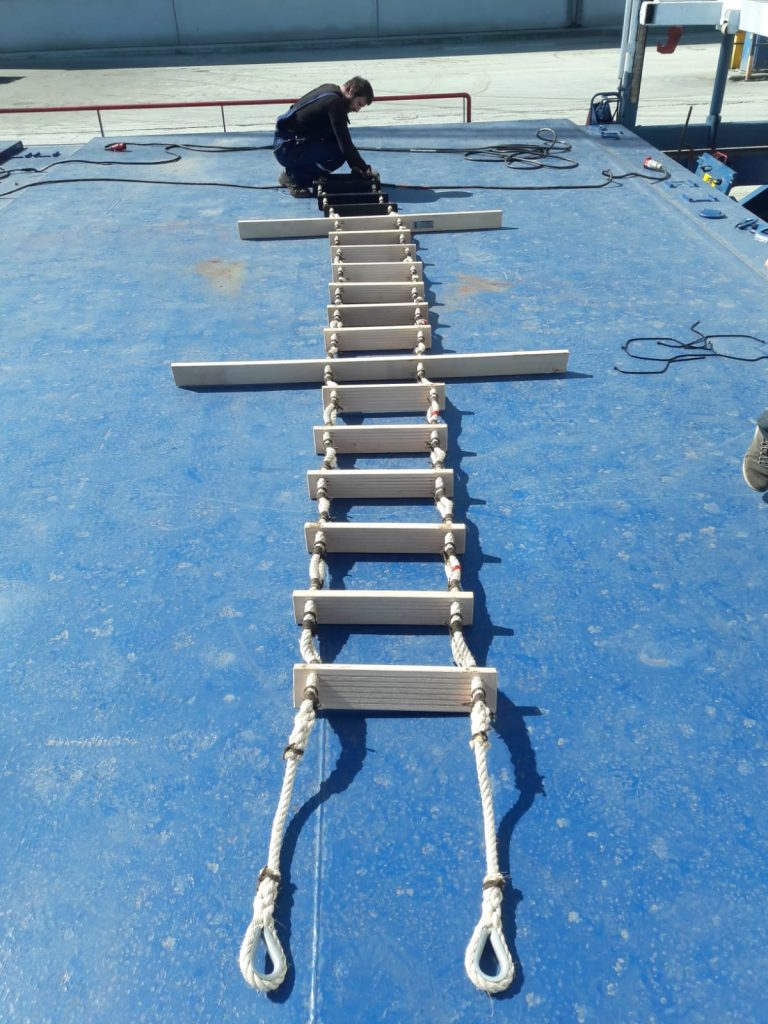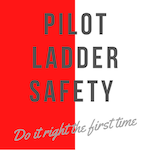
It is clear from the various regulations there is no set inspection interval for pilot ladders. With regards to maintenance and inspection, SOLAS, ISM, ISO and ISM regulations and guidelines apply:
- As per Solas Ch.1 regulation 8, pilot ladders are part of the safety equipment onboard of cargo ships over 500 GT, They are therefore mentioned in the Cargo Ship Safety Equipment Certificate.
- As a result of this, pilot ladders must have a valid certificate, which must be onboard at all times.
- Pilot ladders must be inspected before every use, as well as on a regular basis as per the ships maintenance system, under the governing ISM code certification. (see below)
- Records of maintenance , repair and inspections of pilot ladders are subject to annual flag state inspection SOLAS inspections.
- Pilotladders over 30 months old must have a certificate of strength testing as per ISO 799-1:2019(E) ” 10.4 Each ladder shall be subjected to the ladder and step attachment strength test in Table 2 at not more than 30-month intervals. Each ladder which fails the test shall be rebuilt according to 10.3, or scrapped. The ladder shall be marked with the date of the test and the identification of the person or company performing the test. This marking shall be placed on the same steps as marking required by 8.1 of this document.”
- Pilot ladders that fail an inspection, or that are over 30 months old and have no strength testing certificate, should never be used.
QUIZ: TEST YOUR KNOWLEDGE OF THIS SECTION OF THE WEBSITE (CLICK HERE)
SOLAS V Reg 23: 2. General
2.1. All arrangements used for pilot transfer shall efficiently fulfil their purpose of enabling pilots to embark and disembark safely. The appliances shall be kept clean, properly maintained and stowed and shall be regularly inspected to ensure that they are safe to use. They shall be used solely for the embarkation and disembarkation of personnel.
As per ISM code, the International Safety Management Code (Resolution A.741(18)) :
10 Maintenance of the ship and equipment
10.1 The Company should establish procedures to ensure that the ship is maintained in conformity with the provisions of the relevant rules and regulations and with any additional requirements which may be established by the Company.
10.2 In meeting these requirements the Company should ensure that:
- inspections are held at appropriate intervals;
- any non-conformity is reported with its possible cause, if known;
- appropriate corrective action is taken; and
- records of these activities are maintained.
10.3 The Company should establish procedures in SMS to identify equipment and technical systems the sudden operational failure of which may result in hazardous situations. The SMS should provide for specific measures aimed at promoting the reliability of such equipment or systems. These measures should include the regular testing of stand-by arrangements and equipment or technical systems that are not in continuous use.
10.4 The inspections mentioned in 10.2 as well as the measures referred to 10.3 should be integrated in the ship’s operational maintenance routine. Permanente link
11 Documentation*
11.1 The Company should establish and maintain procedures to control all documents and data which are relevant to the SMS.
11.2 The Company should ensure that:
- valid documents are available at all relevant locations;
- changes to documents are reviewed and approved by authorized personnel; and
- obsolete documents are promptly removed.
11.3 The documents used to describe and implement the SMS may be referred to as the “Safety Management Manual”. Documentation should be kept in a form that the Company considers most effective. Each ship should carry on board all documentation relevant to that ship.
_____________
* Refer to the Revised list of certificates and documents required to be carried on board ships (FAL.2/Circ.127, MEPC.1/Circ.817 and MSC.1/Circ.1462).
